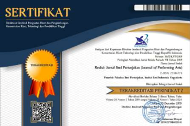Sangku Mencari Riang: Pertemuan Sangkuriang dan Oidipus dalam Perlawanan terhadap Takdir dan Nasib
Abstract
“Sangku mencari Riang” menceritakan pertemuan antara mitos Sangkuriang dari Sunda dan Oidipus dari Yunani Kuno. Cerita ini dibuat sebagai kelanjutan dari cerita rakyat Sangkuriang dengan kisah tragedi Yunani Oidipus Raja karya Sophocles. Cerita yang diciptakan melalui pendekatan intertekstualitas dan interpretasi ini menawarkan makna baru. Cerita ini dibentuk berdasarkan konsep teater rakyat Sunda yang fleksibel dan dinamis dikombinasikan dengan elemen teater Yunani klasik yang melibatkan peran paduan suara dengan kata-kata puitis dalam dialog. Selain itu, penggunaan media dan topeng untuk menyempurnakan karakter menghasilkan estetika bagi penonton. Oleh karena itu, perpaduan konsep antara mitos Sunda dan tragedy Yunani ini memberikan perspektif baru dalam ruang kerja penciptaan seni teater. Hasil kolaborasi dua konsep akan terlihat dalam pertunjukan dengan kekuatan musik, tematik, estetika visual, dan dinamika oral. Dengan cara ini mampu menimbulkan daya tarik bagi para penonton.
Kata kunci: cerita rakyat, intertext, mitos Sunda, teater Yunani.
ABSTRACT
Sangku Looking For Riang Theatre: performances: Sangkuriang meetings and Oedipus in the fight against Destiny and Fate. “Sangku Mencari Riang” is a story which describes the meet of Sangkuriang from Sundanese and Oidipus from Ancient Greek. This story was created as a continuation story of folklore Sangkuriang of Sunda with the story of the Greek tragedy of Sophocles’s work, that is Oidipus the King. Through the intertext study, then, a new interpretation of the story was created, and finally the story of “Sangku Mencari Riang” was offered with its new meaning as well. This story will be perfomed to approach the concept of the folk theater of Sundanese which is regarded as flexible and dynamic, and has a dynamic structure. This concept will be combined with some elements found in the classical Greek theater, in which there is a choir role with poetic words in any dialogues on the performance. Moreover, the use of media which gives the impression of refinement masks of the characters and the ritualistic and aesthetic views for spectators are given to this concept as well. Therefore, these two concepts will provide a new perspective in the work space of theatrical arts creation. Then the result of the collaboration between the two concepts will be seen in the performance with musical powers, essential thematic, visual aesthetics, and oral dynamics, and afterward it will be supposed to give rise to any great attraction for the spectators.
Key words: folklore, intertext, Sundanese myth, Greek Theater.
Full Text:
PDFDOI: https://doi.org/10.24821/resital.v13i2.518
Refbacks
- There are currently no refbacks.
This work is licensed under a Creative Commons Attribution 4.0 International License.



